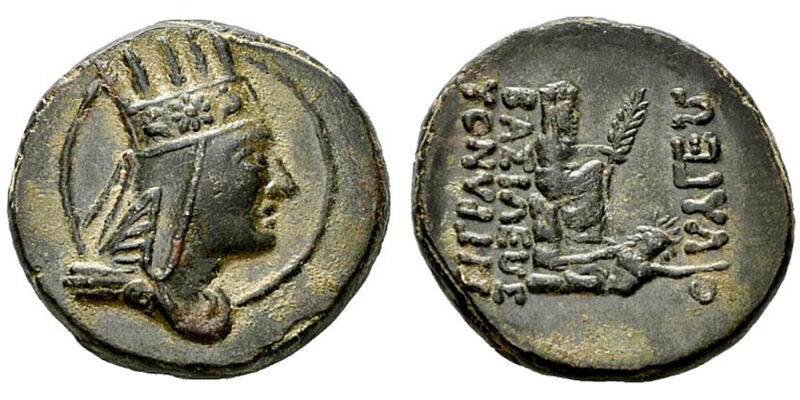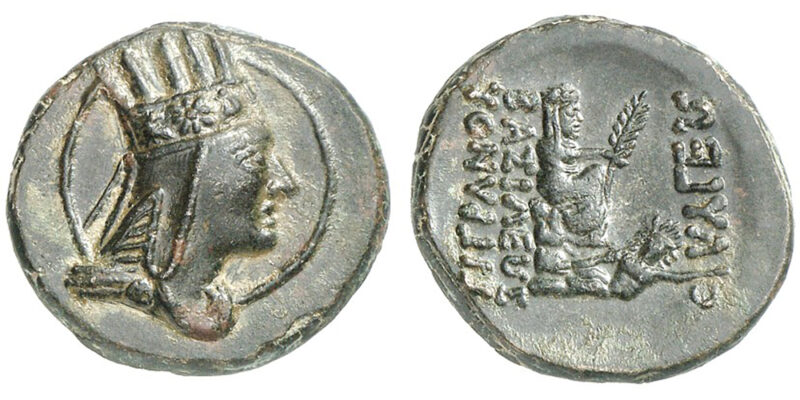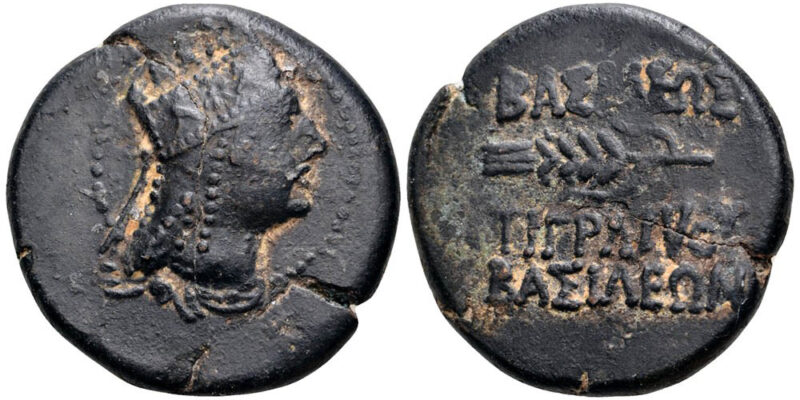By L. A. Saryan, Ph.D
An apparently new bronze coin forgery of Tigranes the Great made its appearance in the European ancient coin market in early 2013. Auction 92 of H. D. Rauch[i] included a bronze (lot 1133, enlarged illustration below, Fig. 1) attributed to Tigranes II of Armenia Major (95-56 BC) with the Antioch Tyche reverse. This piece is very attractive and virtually flawless; both the obverse and reverse faces are nicely centered on a broad flan, the devices are fully struck, and essentially no traces of circulation wear or corrosion are apparent on the surfaces. The obverse depicts the bust of Tigranes facing right, wearing his characteristic tiara, and the reverse depicts the statue of Tyche seated on a rock holding a palm frond with a three-line legend. The piece is attributed as a variety of Nercessian 48[ii] with a blundered legend, from the mint of Antiochia ad Orontem (Syria). The weight is 11.23 grams; the diameter and die rotation are not indicated. Estimated at 600 Euro, the lot reportedly sold for 700 Euro (about $913 US).

Fig. 1. H.D. Rauch Auction 92, Lot 1133
Subsequently, this piece appeared as lot 915 in Gorny & Mosch auction 215[iii], with an estimate of 800 Euro (Fig. 2). It sold for a hammer price of 640 Euro. The G&M example has the exact same weight (11.23 grams), the same flan flaw (obverse 5 o’clock), and the same placement of devices on the flan, indicating that it is the exact same specimen as that sold by Rauch the preceding April. As before, the diameter and die axis are not given. An enlarged photograph of G & M lot 915 is provided below.

Fig. 2. Gomy & Mosch Auction 215, Lot 915
There are several reasons to question the authenticity of this piece:
- The weight is significantly higher than the great majority of genuine coins of the same type. For example, in a hoard of 133 Tigranes II bronze coins published by Bedoukian in 1991 (including 70 normal and 11 overstruck Tyche reverse coins), Tyche reverse coins range in weight from 3.08 grams (lowest) to 9.20 grams (highest).[iv] The weight of the piece described here exceeds the heaviest genuine coin of any type in this hoard by more than 2 grams!
- The tiara peaks on this piece are shaped like narrow fingers with rounded points, whereas on most genuine coins of Tigranes, the peaks are either triangular in shape with a sharp point, or composed of pellets.
- The circular border on the obverse of the subject piece is drawn as a plain solid circle. On genuine bronzes, this circle is constructed using fine pellets.
- The star on the tiara is drawn as if it were a flower with rounded petals.
- The portrait of Tigranes on this piece is awkward, and the space between the ear and neck flaps is not drawn correctly. Specifically, four nearly parallel lines appear in this space; this is never seen on genuine coins. Also, below the ear flap an unusual triangular field mark with a cross can be seen; this too is never seen on genuine silver or bronze coins.
- The legend is blundered beyond any semblance of accuracy. On genuine coins, the three-line legend reads from top to bottom beginning to the right of the statue. Although the lettering here is clear, all three words are spelled incorrectly. Several letters are upside down. The first word is unintelligible, and the first and third words read in the wrong direction.
- On genuine coins of Tigranes, the goddess Tyche always wears a turreted crown. Here, the crown is replaced with a different type of headdress, and the body of Tyche is misshapen.
- The swimmer in the river appears with a radiate crown or headgear. Ordinarily, coins of this type show the swimmer’s head bare.

Roma Numismatics eSale 25, Lot 137 (Newer discovery, auction date 27-Feb-2016)
Hundreds of genuine Tigranes bronzes, of which the Antioch Tyche is the most commonly encountered reverse type, have been described and published over the past four decades. Although these coins typically vary in weight and style from example to example, none are so egregiously incorrect in so many respects as the piece described here. To the best of this author’s knowledge, until its appearance in Rauch auction 92, no example similar to this one had appeared in print.
The provenance of this piece is unknown at present.[v] Although care was obviously taken to fabricate an attractive and eye-appealing imitation, the very serious metrological, epigraphic and stylistic problems noted above indicate that the maker was not familiar with the technical details of genuine Artaxiad coins. In the absence of substantial convincing evidence to the contrary, this piece must be considered a recently manufactured forgery.
[i] Auktionshaus H.D. Rauch is located in Vienna, Austria. Auction 92 was sold on April 22-24, 2013.
[ii] Y. T. Nercessian, Armenian Coins and Their Values (Los Angeles: Armenian Numismatic Society, 1995), p. 62, coin 48.
[iii] Gomy & Mosch Miinzhandlung (abbreviated G&M) is located in Munich, Germany. Auction 215 closed on October 14-15, 2013.
[iv] Paul Z. Bedoukian, A Hoard of Copper Coins of Tigranes the Great and a Hoard of Artaxiad Coins (Los Angeles: Armenian Numismatic Society, 1991), pp. 8-12.
[v] A communication was sent to G&M dated 5 September 2013 requesting evidence that might confirm the authenticity of this lot. A reply has not been received as of this writing.
Saryan, Leon A. “A Recent Bronze Coin Forgery of Tigranes II of Armenia.” Armenian Numismatic Journal, vol. 10 (40), no. 4, Dec. 2014, p. 89-91.
